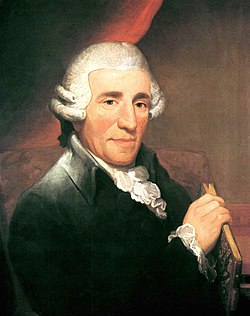
Joseph Haydn's Symphony No. 3 in G major, Hoboken I/3, is believed to have been written between 1760 and 1762.
It is scored for 2 oboes, bassoon, 2 horns, strings and continuo. [1] It was one of the earliest symphonies to have four movements:
The winds are not used in the slow movement, but the trio of the minuet shows "the first emergence of winds from their earlier rôle ... in the earliest divertimenti for winds and strings." [2]
The Minuet is a canon between the higher and lower voices at the distance of one bar. Haydn would later write a similar canon in the minuet of his twenty-third symphony and similar canons would be later be written into G major minuets by Michael Haydn and Mozart. [3] Later still, Haydn himself would develop this technique into the "Canones in Diapason" of the minuet of his Trauer Symphony and the "Witches' Minuet" of his D minor string quartet from Op. 76.[ citation needed ]
The Finale is also contrapuntal. It is a fugue with two subjects that also integrates elements of sonata form. [3]